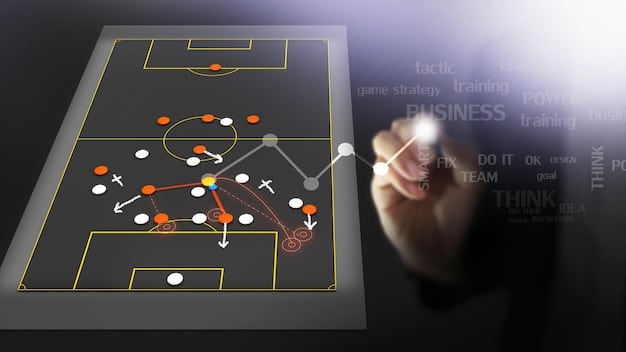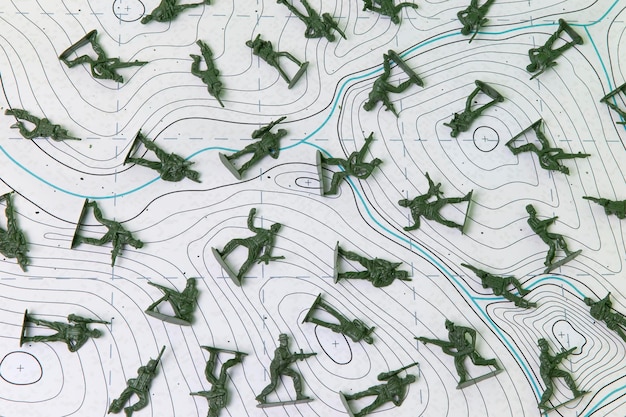Champions League Tactical Analysis: Dominating Formations for 2025

Champions League Tactical Analysis: 3 Formations Set to Dominate the 2025 Season examines the evolving landscape of European football tactics, spotlighting formations poised to shape the upcoming season based on trends, player adaptations, and strategic innovations observed in recent competitions.
Get ready for the future of football! This Champions League Tactical Analysis: 3 Formations Set to Dominate the 2025 Season delves into the strategic masterplans that could define the next era of European club football.
Understanding Tactical Evolution in Champions League
The Champions League is a melting pot of footballing philosophies, where the best teams in Europe showcase their tactical prowess. Analyzing past trends and current innovations is crucial to predicting which formations will reign supreme.
Tactical evolution is driven by several factors, including the rise of new coaching philosophies, the adaptation of players to different roles, and the need to counter specific opponents. In recent years, we’ve seen a shift towards more flexible and dynamic systems.
Key Factors Driving Tactical Changes
Several factors have contributed to the ever-changing tactical landscape:
- Increased Emphasis on Possession: Teams are prioritizing keeping the ball and controlling the tempo of the game.
- Pressing and Counter-Pressing: Winning the ball back quickly in the opponent’s half is now a fundamental aspect of modern football.
- Versatile Players: The demand for players who can perform multiple roles effectively has increased.
These factors have led to the emergence of formations that prioritize fluidity, adaptability, and tactical flexibility. Let’s dive into the specific formations set to dominate the 2025 season.

The Resurgence of the 4-3-3 Formation
The 4-3-3 formation has been a staple of football for decades, but it’s experiencing a resurgence due to its flexibility and attacking potential. Modern interpretations of the 4-3-3 prioritize dynamic movement and positional interchanges.
A well-executed 4-3-3 can provide a solid defensive base while also offering a potent attacking threat. The key to success lies in the quality of the midfield and the synergy between the front three.
Advantages of the 4-3-3
The 4-3-3 formation offers several tactical advantages:
- Wide Attacking Options: The wingers provide natural width, stretching the opposition’s defense.
- Midfield Stability: The midfield trio can control possession and dictate the tempo of the game.
- Pressing Structure: The formation is well-suited for high pressing, allowing teams to win the ball back in advanced areas.
However, the success of the 4-3-3 relies on having players with the right attributes. The midfielders must be technically gifted and physically strong, while the wingers need pace, skill, and the ability to cut inside and create goal-scoring opportunities. The center forward needs to be clinical and effective in holding possession.
In conclusion, the 4-3-3 is not just a classic formation, but a adaptable tool that can still dominate with the right players and execution.
The Rise of the 3-4-3 Diamond Formation
The 3-4-3 diamond formation is a modern take on the classic 3-5-2, offering a unique blend of defensive solidity and attacking flair. The key to this formation is the midfield diamond, which provides creativity, control, and a direct link between defense and attack.
The three central defenders offer stability at the back, while the wing-backs provide width and attacking impetus. The midfield diamond, typically consisting of a holding midfielder, two box-to-box midfielders, and an attacking midfielder, creates a dynamic and unpredictable attacking force.
Key Roles in the 3-4-3 Diamond
The effectiveness of the 3-4-3 diamond hinges on specific player roles:
- Holding Midfielder: Protects the defense and dictates the tempo of the game.
- Box-to-Box Midfielders: Provide energy, creativity, and support for both attack and defense.
- Attacking Midfielder: Creates chances, scores goals, and links the midfield with the front line.
The success of this formation also depends on the understanding and cohesion between the players. The defenders must be comfortable playing in a back three, while the wing-backs need to be athletic and disciplined. The attackers must be clinical and make the most of the chances created by the midfield diamond.

The Versatility of the 4-2-3-1 Formation
The 4-2-3-1 formation is a highly versatile system that can be adapted to suit different opponents and game situations. It provides a solid defensive base with two holding midfielders, while also offering plenty of attacking options with three attacking midfielders and a lone striker.
The key to the 4-2-3-1 is the balance between defense and attack. The two holding midfielders must be disciplined and hardworking, while the attacking midfielders need to be creative and clinical. The lone striker must be able to hold up the ball, bring others into play, and score goals.
Tactical Flexibility of the 4-2-3-1
The 4-2-3-1 offers unmatched tactical flexibility:
- Defensive Solidity: The two holding midfielders provide a shield in front of the defense.
- Attacking Variety: The three attacking midfielders can create chances from various positions.
- Adaptability: The formation can be easily adjusted to a more attacking or defensive approach.
The strength of the 4-2-3-1 lives in its adaptability. The two sitting midfielders could give freedom to the attacking trio, while the fullbacks can push up to create numerical superiority. The lone striker must use his physicality to win aerial duels and hold the ball for midfielders.
In summary, the 4-2-3-1 is expected to be a dominant formation, because it is a highly customizable formation that responds to a variety of strategic needs.
Analyzing Key Player Roles and Attributes
Regardless of the formation used, the success of any team depends on the quality of its players and their ability to perform specific roles effectively. In modern football, certain player attributes are becoming increasingly important.
Versatility is highly valued, as teams need players who can adapt to different positions and roles during a match. Physical attributes such as pace, strength, and stamina are also crucial, as is the ability to press and win the ball back quickly.
Important Modern Football Player Attributes
These attributes are crucial for succeeding in the Champions League:
- Technical Skill: The ability to control the ball, pass accurately, and dribble effectively.
- Tactical Awareness: Understanding the game, making good decisions, and adapting to different situations.
- Mental Strength: The ability to stay focused, handle pressure, and perform consistently.
In conclusion, a combination of these attributes is a recipe to dominate the tactical performance of the Champions League. Without the proper skillset, no formation can give a competitive advantage.
The Influence of Coaching Philosophies
Coaching philosophies play a significant role in shaping tactical trends. Coaches with innovative ideas and a clear vision can have a profound impact on the way the game is played.
In recent years, we’ve seen a rise in coaches who prioritize possession-based football, high pressing, and quick transitions. These philosophies require players to be technically gifted, tactically aware, and physically fit.
Influential Coaching Philosophies
These philosophies have reshaped the modern game:
- Total Football: Emphasizes fluidity, positional interchange, and attacking football.
- Gegenpressing: Focuses on winning the ball back quickly in the opponent’s half.
- Positional Play: Prioritizes controlling possession and creating space with precise passing and movement.
These philosophies have not only influenced the tactical trends, but also player performance and team composition. Versatility and willingness to learn new concepts are becoming vital requirements to play in the Champions League.
Predicting Tactical Adaptations and Counters
As teams continue to evolve and adapt, tactical adaptations and counters will become increasingly important. Coaches will need to be able to anticipate their opponents’ strategies and develop plans to neutralize their strengths.
One potential trend is the rise of more asymmetric formations, where teams adopt different shapes in possession and out of possession. This can make it more difficult for opponents to prepare and can create tactical mismatches.
Anticipating Future Tactical Trends
Important future trends will keep coaches on their toes, so they can prepare their players technically and mentally:
- Asymmetric Formations: Using different shapes in and out of possession to create tactical mismatches.
- Dynamic Pressing Schemes: Varying the pressing intensity and triggers to disrupt the opponent’s build-up play.
- Set-Piece Innovation: Developing creative routines to maximize the effectiveness of set-pieces.
In conclusion, the future of the Champions League will be defined by constant evolution, tactical nuances, and adaptive approaches. The difference between victory and defeat will depend on the ability to adjust to new paradigms.
| Key Point | Brief Description |
|---|---|
| ⚽ Tactical Evolution | Champions League tactics are constantly changing. |
| 🛡️ 4-3-3 Formation | A flexible system emphasizing possession and attacking options. |
| 💎 3-4-3 Diamond | Defensive solidity with a creative midfield diamond. |
| 🔄 4-2-3-1 Versatility | Adaptable to various opponents offering balance. |
Frequently Asked Questions
▼
Tactical changes come from new philosophies, player adaptation, and the need to counter specific opponents, emphasizing flexibility and dynamism.
▼
Due to its flexibility and attacking potential, modern versions prioritize dynamic movement and positional interchange, creating both solid defense and potent offense.
▼
It offers creativity, control, and a direct link between defense and attack, making it a dynamic and unpredictable attacking force for the team.
▼
It provides a solid defensive base with two holding midfielders and offers plenty of attacking options with three attacking midfielders plus a solo striker.
▼
Because the rise of asymmetric formations and dynamic pressing schemes means players who can adapt to varied roles are more useful in matches.
Conclusion
As we look ahead to the 2025 Champions League season, it’s clear that tactical innovation and adaptability will be more critical than ever. The formations discussed – the 4-3-3, 3-4-3 diamond, and 4-2-3-1 – each offer unique strengths and potential, and their success will depend on the quality of the players, the coaching philosophies in place, and the ability to anticipate and counter opponents’ strategies. The future of European football promises to be an exciting blend of strategic brilliance and athletic prowess.





